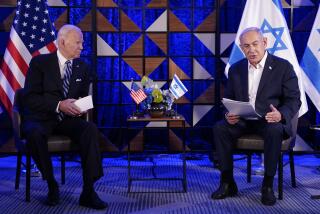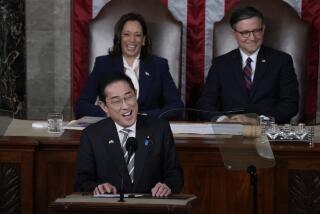PERSPECTIVE ON THE U.S./JAPAN RELATIONSHIP : Promises of ‘Change’ Ring Hollow : One year later, there’s been little progress on lowering the trade gap and breaking down import barriers.
- Share via
The relationship between the United States and Japan is in serious disrepair. Japan’s huge account surplus, low level of manufactured imports, minuscule inward foreign direct investment and barriers to foreign products and services persist unabated. Why has there been so little progress despite the inauguration last year in both nations of governments espousing “change”? The answer is inattention, complacency and missed opportunity.
Inattention to the relationship has been abetted by a sense of complacency in both countries. In the United States, this complacency has three sources.
First, exaggerated media accounts have misled Americans into believing that “the Japanese sun has set.” Although the current recession has lasted longer than expected, the fundamental strengths of the Japanese economy remain intact. Within 12 to 18 months, the cost-cutting, rationalization and restructuring to squeeze out the excesses of the “bubble economy” of the late 1980s and early ‘90s will have had their effect, and Japan will again emerge as a formidable competitor. Americans should substitute wishful thinking with objective and realistic analyses of long-term Japanese global economic strategy.
Second is the mistaken notion that the “reforms” advocated by Prime Minister Morihiro Hosokawa--and passed by the Diet on Saturday after being rejected by the Upper House on Jan. 21--would benefit not only Japan but also its trading partners, in particular the United States. This fallacy was premised on the assumption that the realignment of political parties in Japan would automatically lead to a more open, transparent, consumer-oriented society.
Third, the Clinton Administration appears to believe that asymmetries in the economic relationship can be remedied simply by asking Japan to commit to “results”--whether in its current-account surplus, aggregate level of manufactured imports or sector-specific imports. There is an evident lack of appreciation of the profound complexities and difficulties facing foreign firms attempting to export to or invest in Japan and the attention, expertise and resources necessary on the part of the U.S. government and corporations to penetrate the multilayered and deeply rooted barriers posed by the Japanese market. The Administration also lacks an understanding of where, when and how much pressure should be applied for maximum results and minimal Japanese resentment.
On the Japanese side, complacency stems from the perception that the United States is too preoccupied with its own domestic problems and with foreign-policy crises to worry much about Japan. There is also a sense that the United States is increasingly dependent on Japan’s goodwill and support--whether for “strategic alliances” between corporations, security cooperation as on the Korean peninsula, personnel for peacekeeping operations as in Cambodia or for financial assistance as in Russia and the Middle East.
As for opportunity, the Clinton Administration missed a golden one in early 1993 to set a fundamentally new course for the U.S.-Japan relationship. Japanese officials and business leaders fully expected the new Administration to institute policies that would force Japan to accept more U.S. products, services and investment in return for continued access to the U.S. market.
Rhetoric coming from the Clinton team certainly gave that impression. By calling for “results,” “targets” and “objective indicators,” the Administration put Japan on notice that, unlike the Republicans, it would not settle for mere changes in procurement rules or procedures. But the flaw was threefold.
First, the rhetoric was not supported by a clear, coherent, consistent policy toward Japan. Depending on the day and the official being quoted, the request or “demand” was described as targets, goals, results, objective criteria, quantitative indicators, qualitative indicators, benchmarks, yardsticks, reciprocity, transparency or none of the above. The clear impression left in Japan was that the Administration was wavering.
Second, the Administration’s inattention early on allowed Japan to undertake a remarkably successful public-relations campaign that depicted the United States as a “protectionist” nation advocating “managed trade.” Southeast Asian countries and many members of the Organization for Economic Cooperation and Development were persuaded by Japan that if the United States were successful in pursuing a results-oriented trade policy toward it, they, too, would face similar pressures.
Third, the U.S. rhetoric was not backed up by action. The Administration failed to understand the cardinal principle in negotiating with Japan: Speak softly and carry a big stick. Instead, the Administration did the opposite; it cried wolf repeatedly but took no action. From Tokyo’s perspective, the construction scandal was a test of whether the Clinton team would act differently from the Reagan and Bush teams. With more than 30 senior Japanese government officials and executives arrested in 1993 for bid-rigging, bribery and collusion in the construction industry, many Japanese knew that if there was ever a clear case of illegal activity that excluded competitive foreign companies from the Japanese market, this was it. Inaction by the Clinton Administration was seen in Japan not as a gesture of generosity but as a sign of weakness.
More to Read
Sign up for Essential California
The most important California stories and recommendations in your inbox every morning.
You may occasionally receive promotional content from the Los Angeles Times.













